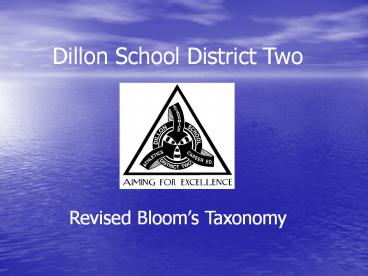BLOOM’s REVISED TAXONOMY - PowerPoint PPT Presentation
1 / 23
Title:
BLOOM’s REVISED TAXONOMY
Description:
Dillon School District Two Revised Bloom s Taxonomy Bloom Revised Bloom Q: What happened to knowledge? Remember retrieve relevant knowledge from long term ... – PowerPoint PPT presentation
Number of Views:527
Avg rating:3.0/5.0
Title: BLOOM’s REVISED TAXONOMY
1
Dillon School District Two Revised Blooms
Taxonomy
2
Revised Blooms Taxonomy The revised taxonomy
is two-dimensional, identifying both the kind of
knowledge to be learned (knowledge dimension) and
the kind of learning expected from students
(cognitive processes) to help teachers and
administrators improve alignment and rigor in the
classroom. This taxonomy will assist educators
to improve instruction, to ensure that their
lessons and assessments are aligned with one
another and with the state academic standards,
that their lessons are cognitively rich, and that
instructional opportunities are not missed.
3
The Original Blooms Taxonomy
The Original Blooms Taxonomy
The Original Blooms Taxonomy
4
Bloom Revised Bloom
- Create
- Evaluation
- Evaluate
- Synthesis
- Analyze
- Analysis
- Apply
- Application
- Understand
- Comprehension
- Remember
- Knowledge
5
IN COMBINATION THE SIX REVISED CATEGORIES ARE
TERMED COGNITIVE PROCESS CATEGORIES AND THEY
EXIST ALONG THE COGNITIVE PROCESS DIMENSION.
6
Q What happened to knowledge?
A It became a separate dimension The
Knowledge Dimension
7
Cognitive Process Dimension
Knowledge Dimension
8
THE TAXONOMY TABLE
COGNITIVE PROCESS DIMENSION
KNOWLEDGE DIMENSION
9
Cognitive Process Dimension
10
Remember
- retrieve relevant knowledge from long term
memory - Recognizing
- Recalling
- Can you recall the name of a particular object?
11
Understand
- Construct meaning from instructional messages,
including oral, written and graphic
communication. - Interpreting
- Exemplifying
- Classifying
- Summarizing
- Inferring
- Comparing
- Explaining
Can you represent verbal information visually
(interpreting)?
12
Apply
- Carry out or use a procedure in a given
situation. - Executing
- Implementing
Can you use information in another situation?
13
Analyze
- Break material into its constituent parts and
determine how the parts relate to one another and
to an overall structure or purpose. - Differentiating
- Organizing
- Attributing
Can you break information into parts to explore
relationships?
14
Evaluate
- make judgments based on criteria and standards
- Checking
- Critiquing
Can you make justify a decision or course of
action?
15
Create
- Put elements together to form a coherent or
functional whole reorganize elements into a new
pattern or structure - Generating
- Planning
- Producing
Can you generate new products, ideas, or ways
of viewing things?
16
Knowledge Dimension
17
- Factual Knowledge
- Conceptual Knowledge
- Procedural Knowledge
- Metacognitive Knowledge
18
- HOT ARTICHOKE DIP (Serves 10 to 14)
- 2 14-oz cans artichoke hearts
- 16 oz. mayonnaise
- 1 c. grated Parmesan cheese
- Garlic salt (optional)
- Drain artichoke hearts.
- Mash artichokes with fork.
- Mix with mayonnaise, cheese, and garlic salt.
- Bake at 350 degrees for 15 minutes or until
cheese is melted. - Serve with crackers or party rye.
19
Factual Knowledge
- The basic elements students must know to be
acquainted with a discipline or solve problems in
it. - Knowledge of terminology
- Knowledge of specific details and elements
20
Conceptual Knowledge
- The interrelationships among the basic elements
within a larger structure that enable them to
function together. - Knowledge of classifications and categories
- Knowledge of principles and generalizations
- Knowledge of theories, models and structures
21
Procedural Knowledge
- How to do something, methods of inquiry and
criteria for using skills, algorithms, techniques
and methods. - Knowledge of subject-specific skills and
algorithms - Knowledge of subject-specific techniques and
methods - Knowledge of criteria for determining when to use
appropriate procedures
22
Metacognitive Knowledge
- Knowledge of cognition in general as well as
awareness and knowledge or ones own cognition. - Strategic knowledge
- Knowledge about cognitive tasks, including
appropriate contextual and conditional knowledge - Self-knowledge
How did I get that answer?
23
THE TAXONOMY TABLE
COGNITIVE PROCESS DIMENSION
1. REMEMBER Recognizing Recalling
2. UNDERSTAND Interpreting Exemplifying Classifyin
g Summarizing Inferring Comparing Explaining
3. APPLY Executing Implementing
4. ANALYZE Differentiating Organizing Attributing
5. EVALUATE Checking Critiquing
6. CREATE Generating Planning Producing































